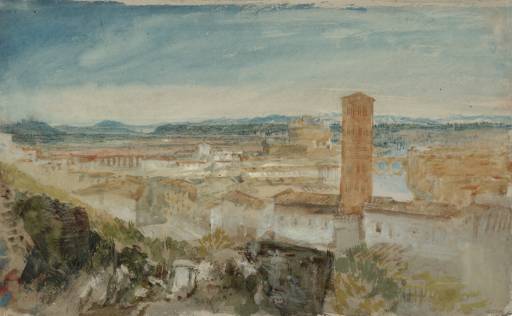Joseph Mallord William Turner View of Rome from the Gardens of the Villa Barberini 1819
Joseph Mallord William Turner,
View of Rome from the Gardens of the Villa Barberini
1819
Joseph Mallord William Turner 1775–1851
View of Rome from the Gardens of the Villa Barberini 1819
D16329
Turner Bequest CLXXXIX 3
Turner Bequest CLXXXIX 3
Gouache, pencil, grey watercolour wash and watercolour on white wove ‘Valleyfield’ paper, 229 x 366 mm
Inscribed by an unknown hand in blue ink ‘F.7’ bottom right
Stamped in black ‘CLXXXIX 3’ bottom right
Inscribed by an unknown hand in blue ink ‘F.7’ bottom right
Stamped in black ‘CLXXXIX 3’ bottom right
Accepted by the nation as part of the Turner Bequest 1856
Exhibition history
1904
National Gallery, London, various dates to at least 1904 (255).
1934
Watercolours from the Turner Bequest, Victoria and Albert Museum, London, March 1934–? (no catalogue).
1971
[?] Victoria and Albert Museum Circulation Department Conservation Studio, London, circa 1971 (no catalogue).
1975
Turner in the British Museum: Drawings and Watercolours, British Museum, London, May 1975–February 1976 (69, reproduced, as ‘Rome: The Tiber and Castel S. Angelo from S. Onofrio’).
1983
J.M.W. Turner, à l’occasion du cinquantième anniversaire du British Council, Galeries nationales du Grand Palais, Paris, October 1983–January 1984 (147, reproduced, as ‘Rome: le Tibre et le château Saint-Ange vus de Sant’Onofrio’).
References
1904
E.T. Cook and Alexander Wedderburn (eds.), Library Edition: The Works of John Ruskin: Volume XIII: Turner: The Harbours of England; Catalogues and Notes, London 1904, no.255, pp.378, 622, as ‘The Tiber and Castle of St. Angelo’.
1909
A.J. Finberg, A Complete Inventory of the Drawings of the Turner Bequest, London 1909, vol.I, p.562, as ‘The Tiber and Castle of St. Angelo. Water colour. 255, N.G.’.
1920
D[ugald] S[utherland] MacColl, National Gallery, Millbank: Catalogue: Turner Collection, London 1920, p.87.
1925
Thomas Ashby, Turner’s Visions of Rome, London and New York 1925, p.24, reproduced between pp.12–13 pl.8, as ‘The Tiber and Castle of St. Angelo’.
1975
Andrew Wilton, Turner in the British Museum: Drawings and Watercolours, exhibition catalogue, British Museum, London 1975, no.69, p.54, reproduced, as ‘Rome: The Tiber and Castel S. Angelo from S. Onofrio’.
1983
John Gage, Jerrold Ziff, Nicholas Alfrey and others, J.M.W. Turner, à l’occasion du cinquantième anniversaire du British Council, exhibition catalogue, Galeries nationales du Grand Palais, Paris 1983, no.147, p.221, reproduced p.220, as ‘Rome: le Tibre et le château Saint-Ange vus de Sant’Onofrio’.
As Thomas Ashby first identified, Turner’s location for this view of Rome was the Villa Barberini (also known as the Villa Barberini al Gianicolo), a small Baroque casino situated north of the Janiculum Hill, to the immediate south of St Peter’s and the Vatican. Originally owned by Taddeo Barberini, nephew of Pope Urban VIII, the building was largely destroyed during the siege of Rome in 1849,1 but its appearance is partially recorded in an eighteenth-century engraving by Giuseppe Vasi (1710–1782).2 Two small pavilions, the Casino della Palma, and the Palazetto Vercelli survived and are today part of a larger complex owned by the Jesuits and the Collegio di Propoganda Fide.
During the nineteenth century, the Villa Barberini was set within terraced gardens which offered spectacular views across the city. This sketch depicts the prospect looking north towards the Castel Sant’Angelo with the bell-tower of the Church of Santo Spirito in Sassia in the immediate foreground. On the right is the River Tiber and the Ponte Sant’Angelo, and on the left, the northern outskirts of the city, known as the Prati di Castello, with Monte Mario on the far side, and Monte Soracte in the distance beyond. Several other panoramic studies from the Villa Barberini can be found within this sketchbook (see D16327, D16333, D16347, D16358, D16361, D16374; Turner Bequest CLXXXIX 1, 7, 21, 32, 34, 45a) and there is also a single related sketch in the Albano, Nemi, Rome sketchbook (see Tate D15368; Turner Bequest CLXXXII 39).
Like many drawings within the Rome C. Studies sketchbook, the composition has been executed over a washed grey background. Turner first sketched a rough pencil outline before more fully developing the view in watercolour and gouache. He also created highlights by rubbing or scratching through to the white paper beneath. The use of blue for the distant mountains beyond recalls the effects of aerial perspective which characterise the paintings of the seventeenth-century master Claude Lorrain (circa 1600–1682).
Verso:
Blank, except for traces of watercolour; inscribed by an unknown hand(s) in pencil ‘CLXXXIX.3’ bottom centre and ‘3’ encircled, centre, and stamped in black ‘CLXXXIX 3’ bottom centre.
Nicola Moorby
July 2009
How to cite
Nicola Moorby, ‘View of Rome from the Gardens of the Villa Barberini 1819 by Joseph Mallord William Turner’, catalogue entry, July 2009, in David Blayney Brown (ed.), J.M.W. Turner: Sketchbooks, Drawings and Watercolours, Tate Research Publication, December 2012, https://www

